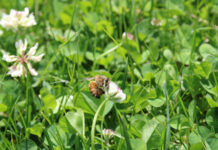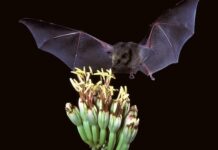 Though it was rainy and cold last Thursday in Roseville, MN, inside the Roseville Skate Center, attendees of the “Lawns to Legumes Workshop” were already thinking and planning for Spring. Specifically, they were learning about a new program whereby Minnesota landowners can actually receive up to $350 to help convert their grass lawns into pollinator friendly habitats. Minnesota landscapers take note: this could be a great program to promote among your clients!
Though it was rainy and cold last Thursday in Roseville, MN, inside the Roseville Skate Center, attendees of the “Lawns to Legumes Workshop” were already thinking and planning for Spring. Specifically, they were learning about a new program whereby Minnesota landowners can actually receive up to $350 to help convert their grass lawns into pollinator friendly habitats. Minnesota landscapers take note: this could be a great program to promote among your clients!
Earlier this year, Minnesota passed legislation setting aside approximately $900,000 to assist homeowners in the effort to install wildflowers, clover, and other native plantings on their properties. The Lawns to Legumes program aims to protect the Minnesota state bee, the rusty patched bumblebee (which has declined by 87% in the last 20 years and was the first bee in the continental U.S. to be labeled an Endangered Species), and other at-risk pollinators by helping to counteract issues like habitat loss and pesticide use.
Will more states follow suit? Perhaps. On Tuesday, the National Fish and Wildlife Foundation (NFWF) announced ten grants totaling more than $1.5 million to projects geared toward conserving monarch butterflies, rusty patched bumblebees, and other insect pollinators in nine states across the U.S., including Arizona, California, Iowa, Illinois, Michigan, Oklahoma, Texas, Wisconsin, and Minnesota. The grants will generate more than $2.8 million in matching contributions for a total conservation impact of more than $4.4 million.
“These projects will restore and improve habitat for monarch butterflies and other at-risk native pollinators, which are vital to the nation’s ecosystems and economy,” said Jeff Trandahl, executive director and CEO of NFWF. “By helping private landowners and other land managers deliver on-the-ground conservation, the grants announced today will benefit not only these important insects, but also the many other wildlife species and human communities that rely on pollinators for critical ecological services.”
Collectively, the funded projects will:
- Restore and enhance more than 24,000 acres of pollinator habitat
- Collect more than 100 pounds of milkweed seed
- Propagate more than 12,000 milkweed seedlings
- Host 179 workshops and meetings focused on pollinator conservation
The 2019 grants were awarded through the Monarch Butterfly and Pollinators Conservation Fund. This year’s funding partners include Shell, the U.S. Department of Agriculture’s Natural Resources Conservation Service and Forest Service, and the U.S. Department of Interior’s Bureau of Land Management and Fish and Wildlife Service.
In Minnesota, Blue Thumb, a public/private partnership that promotes ecologically functional landscapes, and Metro Blooms, will manage the individual support function of Lawns to Legumes for the Minnesota Board of Water and Soil Resources (BWSR), who are administering the program. Workshops, like the one mentioned above, are currently being held across the state by Blue Thumb. Check here for dates and locations.
 Next month, Blue Thumb will begin accepting applications from residents for the first round of individual funding. The program divides the state into three priority areas based on the presence of the state bumblebee. Applicants who live in areas with a high potential for the rusty patched bumblebee to be present – such as Minneapolis, St. Paul, Rochester, Mankato, and Section Ten Lake – will be given priority. A map, shown left, is available for MN residents to check their priority area. Residents who wish to receive updates on the program can sign up here.
Next month, Blue Thumb will begin accepting applications from residents for the first round of individual funding. The program divides the state into three priority areas based on the presence of the state bumblebee. Applicants who live in areas with a high potential for the rusty patched bumblebee to be present – such as Minneapolis, St. Paul, Rochester, Mankato, and Section Ten Lake – will be given priority. A map, shown left, is available for MN residents to check their priority area. Residents who wish to receive updates on the program can sign up here.
Applicants who are accepted will receive the funding through a reimbursement process. Funding decisions will be made and all notifications e-mailed in February for spring 2020 installations. A second application round will open in March 2020, for summer and fall installations. John Bly of Metro Blooms says he hopes the program will receive more funding if there’s a lot of applications submitted.
In the meantime, the Lawns to Legumes project has developed a variety of resources to help plan a pollinator habitat. A helpful webinar is also available.











![[VIDEO] Dickies®: Discover Workwear That’s Anything But Uniform](https://turfmagazine.com/wp-content/uploads/2023/06/1647663814-4b1a2a7742790a9b1e97a3b963477850192e1d6a9dfba9b07214a77bae25d6e3-d-218x150.jpg)






























![[VIDEO] Dickies®: Discover Workwear That’s Anything But Uniform](https://turfmagazine.com/wp-content/uploads/2023/06/1647663814-4b1a2a7742790a9b1e97a3b963477850192e1d6a9dfba9b07214a77bae25d6e3-d-324x160.jpg)